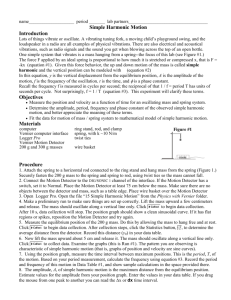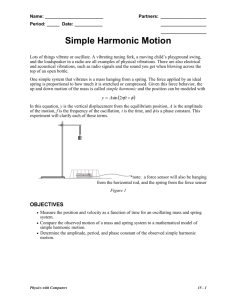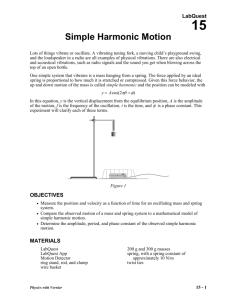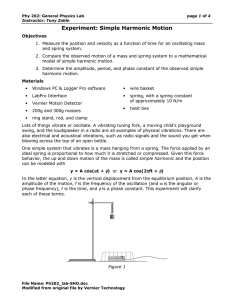Simple Harmonic Motion
advertisement
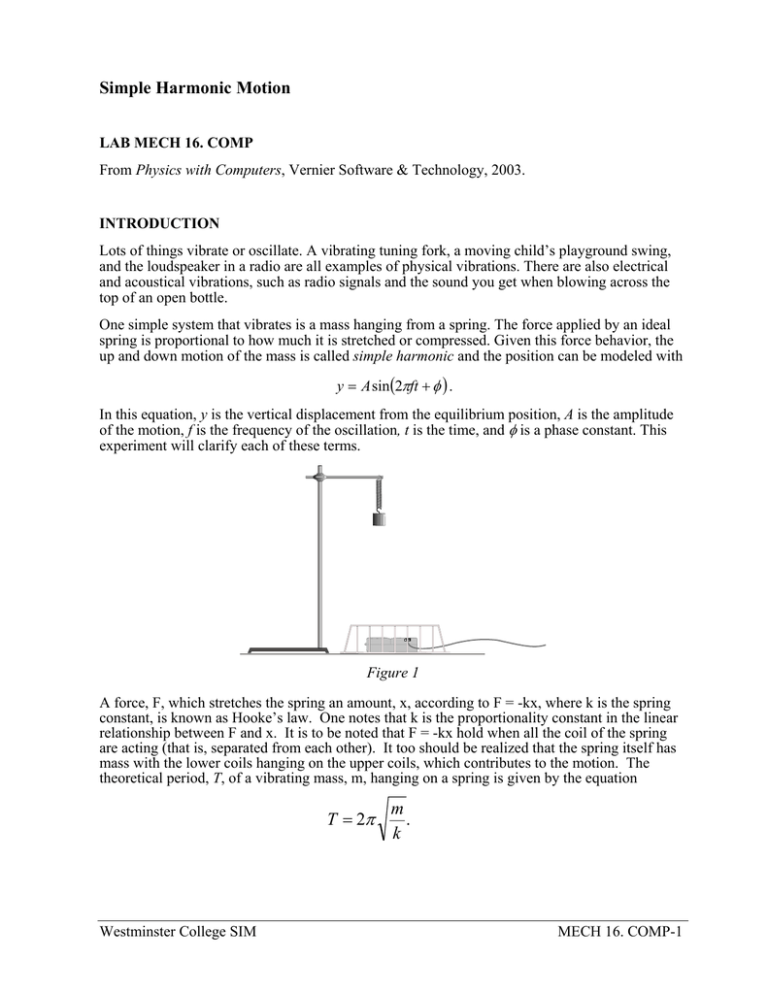
Simple Harmonic Motion LAB MECH 16. COMP From Physics with Computers, Vernier Software & Technology, 2003. INTRODUCTION Lots of things vibrate or oscillate. A vibrating tuning fork, a moving child’s playground swing, and the loudspeaker in a radio are all examples of physical vibrations. There are also electrical and acoustical vibrations, such as radio signals and the sound you get when blowing across the top of an open bottle. One simple system that vibrates is a mass hanging from a spring. The force applied by an ideal spring is proportional to how much it is stretched or compressed. Given this force behavior, the up and down motion of the mass is called simple harmonic and the position can be modeled with y = A sin (2πft + φ ) . In this equation, y is the vertical displacement from the equilibrium position, A is the amplitude of the motion, f is the frequency of the oscillation, t is the time, and φ is a phase constant. This experiment will clarify each of these terms. Figure 1 A force, F, which stretches the spring an amount, x, according to F = -kx, where k is the spring constant, is known as Hooke’s law. One notes that k is the proportionality constant in the linear relationship between F and x. It is to be noted that F = -kx hold when all the coil of the spring are acting (that is, separated from each other). It too should be realized that the spring itself has mass with the lower coils hanging on the upper coils, which contributes to the motion. The theoretical period, T, of a vibrating mass, m, hanging on a spring is given by the equation T = 2π Westminster College SIM m . k MECH 16. COMP-1 Simple Harmonic Motion PURPOSE The approach of this experiment is to study the position and velocity of an oscillating mass and spring system as a function of time and to relate the behavior to the mathematical model of simple harmonic motion, thereby obtaining parameters of the motion. These theoretical parameters are to be compared to experimentally observed values of amplitude and period with the phase constant also noted. By obtaining the spring phase constant, the theoretical period is calculated for a particular mass and compared with that experimentally obtained. MATERIALS Computer Vernier computer interface Logger Pro Vernier Motion Detector 200 g and 300 g masses ring stand, clamp/arm spring, with a spring constant of approximately 10 N/m masking tape wire basket PRELIMINARY QUESTIONS 1. Attach the 200 g mass to the spring and hold the free end of the spring in your hand, so the mass and spring hang down with the mass at rest. Lift the mass about 10 cm and release. Observe the motion. Sketch a graph of position vs. time for the mass. 2. Just below the graph of position vs. time, and using the same length time scale, sketch a graph of velocity vs. time for the mass. PROCEDURE 1. Attach the spring to a horizontal clamp/arm connected to the ring stand and hang the mass from the spring as shown in Figure 1. Securely fasten the 200 g mass to the spring and the spring to the rod, using masking tape so the mass cannot fall. 2. Connect the Motion Detector to the DIG/SONIC 1 channel of the interface. 3. Place the Motion Detector at least 75 cm below the mass. Make sure there are no objects near the path between the detector and mass, such as a table edge. Place the wire basket over the Motion Detector to protect it. 4. Open the file “15 Simple Harmonic Motion” from the Physics with Computers folder. 5. Make a preliminary run to make sure things are set up correctly. Lift the mass upward a few centimeters and release. The mass should oscillate along a vertical line only and without or to begin data collection. minimum rotation. Click 6. After 10 s, data collection will stop. The position graph should show a clean sinusoidal curve. If it has flat regions or spikes, reposition the Motion Detector and try again. 7. Compare the position graph to your sketched prediction in the Preliminary Questions. How are the graphs similar? How are they different? Also, compare the velocity graph to your prediction. Westminster College SIM MECH 16. COMP-2 Simple Harmonic Motion 8. Measure the equilibrium position of the 200 g mass. Do this by allowing the mass to hang free and at rest. Click to begin data collection. After collection stops, click the Statistics button, , to determine the average distance from the detector. Record this distance (y0) in the Data Table. 9. Now lift the mass upward about 5 cm and release it. The mass should oscillate along a vertical line only. Click to collect data. Examine the graphs. The pattern you are observing is characteristic of simple harmonic motion. 10. Using the position graph, measure the time interval between maximum positions. This is the period, T, of the motion. To obtain a representative value, click on Examine and obtain the time values corresponding to the maximum position values from near the beginning and end of the position versus time graph. Take the difference in these time values and divide by the number of cycles to obtain T. The frequency, f, is the reciprocal of the period, f = 1/T. Based on your period measurement, calculate the frequency. Record the period and frequency of this motion in the Data Table. 11. The amplitude, A, of simple harmonic motion is the maximum distance that the vibrating mass moves from the equilibrium position. Again click on examine to obtain adjacent maximum and minimum position values and take one-half of their different, thus the amplitude, A. Enter the values in the Data Table. 12. For Run 2, repeat Steps 8 – 11 with the same 200 g mass, moving with a larger amplitude (about 10 or more cm) than in the first run. 13. To obtain data for determining k, measure the equilibrium position as in step 8 above of a hanging mass of 150g on the spring and then of 300g on the spring. Record the positions in the Data Table. 14. For Run 3, now the 300 g mass repeat Steps 8 – 11. Again, use an amplitude of about 5 cm. KEEP a good run made with this 300 g mass on the screen. You will use it for several of the Analysis questions. DATA TABLE Run Mass (g) y0 (cm) A (cm) T (s) f (Hz) 1 2 3 150 g position 300 g position Mass of Spring Westminster College SIM (m) (m) (g) MECH 16. COMP-3 Simple Harmonic Motion ANALYSIS 1. View the graphs of the last run on the screen. Compare the position vs. time and the velocity vs. time graphs. How are they the same? How are they different? 2. Turn on the Examine mode by clicking the Examine button, . Move the mouse cursor back and forth across the graph to view the data values for the last run on the screen. Where is the mass when the velocity is zero? Where is the mass when the velocity is greatest? 3. Does the frequency, f, appear to depend on the amplitude of the motion? Do you have enough data to draw a firm conclusion? 4. Does the frequency, f, appear to depend on the mass used? Did it change much in your tests? 5. Compute the spring constant, k, from the data taken in step 14 above with x1 and x2 the position values where (.300kg − .150kg ) k= 9.8m / s 2 . x 2 − x1 6. Compute the theoretical value of T = 2π m for each run. Compare with your experimental T values. Then, calculate T for k these runs including one-third the mass of the spring as part of the vibrating mass value. Compare and discuss. 7. You can compare your experimental data to the sinusoidal function model using the Manual Curve Fit feature of Logger Pro. Try it with your 300 g data. The model equation in the introduction, which is similar to the one in many textbooks, gives the displacement from equilibrium. However, your Motion Detector reports the distance from the detector. To compare the model to your data, add the equilibrium distance to the model; that is, use y = A sin (2πft + φ ) + y 0 where y0 represents the equilibrium distance. a. Click once on the position graph to select it. b. Choose Curve Fit from the Analyze menu. c. Select Manual as the Fit Type. d. Select the Sine function from the General Equation list. e. The Sine equation is of the form y=A*sin(Bt +C) + D. Compare this to the form of the equation above to match variables; e.g., φ corresponds to C, and 2πf corresponds to B and y0 to D. f. Adjust the values for A, B and D to reflect your values for A, f and y0. You can either enter the values directly in the dialog box or you can use the up and down arrows to adjust the values. g. The phase parameter φ is called the phase constant and is used to adjust the y value reported by the model at t = 0 so that it matches your data. Since data collection did not necessarily begin when the mass was at the equilibrium position, φ is needed to achieve a good match as it shifts the matching sine pattern left or right as you enter a + or a – value for φ. Estimate the approximate fraction of a cycle, between 0 and 2π, needed to shift the pattern to be in phase. Westminster College SIM MECH 16. COMP-4 Simple Harmonic Motion h. Adjust and test to find a value for φ that makes the model come as close as possible to the data of your 300 g experiment. You may also want to adjust y0, A, and f to improve the fit. Write down the equation that best matches your data. 8. Predict what would happen to the plot of the model if you doubled the parameter for A by sketching both the current model and the new model with doubled A. Now double the parameter for A in the manual fit dialog box to compare to your prediction. 9. Similarly, predict how the model plot would change if you doubled f, and then check by modifying the model definition. 10. Click , and optionally print your graph. EXTENSIONS 1. Investigate how changing the spring amplitude changes the period of the motion. Take care not to use too large an amplitude so that the mass does not come closer than 40 cm to the detector or fall from the spring. 2. How will damping change the data? Tape an index card to the bottom of the mass and collect additional data. You may want to take data for more than 10 seconds. Does the model still fit well in this case? 3. Do additional experiments to discover the relationship between the mass and the period of this motion. Westminster College SIM MECH 16. COMP-5

